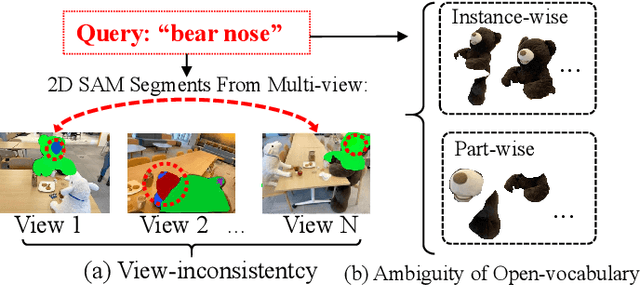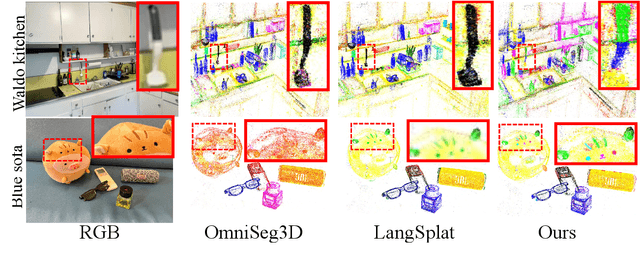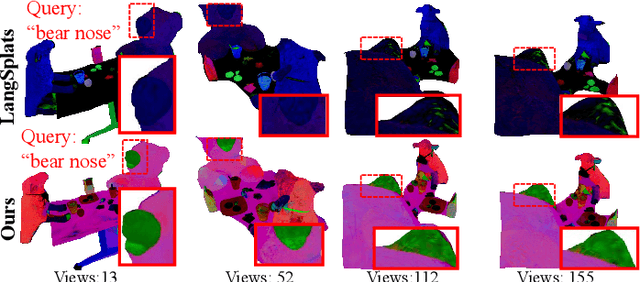Hongwei Wang
LeanCat: A Benchmark Suite for Formal Category Theory in Lean (Part I: 1-Categories)
Dec 31, 2025Abstract:Large language models (LLMs) have made rapid progress in formal theorem proving, yet current benchmarks under-measure the kind of abstraction and library-mediated reasoning that organizes modern mathematics. In parallel with FATE's emphasis on frontier algebra, we introduce LeanCat, a Lean benchmark for category-theoretic formalization -- a unifying language for mathematical structure and a core layer of modern proof engineering -- serving as a stress test of structural, interface-level reasoning. Part I: 1-Categories contains 100 fully formalized statement-level tasks, curated into topic families and three difficulty tiers via an LLM-assisted + human grading process. The best model solves 8.25% of tasks at pass@1 (32.50%/4.17%/0.00% by Easy/Medium/High) and 12.00% at pass@4 (50.00%/4.76%/0.00%). We also evaluate LeanBridge which use LeanExplore to search Mathlib, and observe consistent gains over single-model baselines. LeanCat is intended as a compact, reusable checkpoint for tracking both AI and human progress toward reliable, research-level formalization in Lean.
Stop Wasting Your Tokens: Towards Efficient Runtime Multi-Agent Systems
Oct 30, 2025Abstract:While Multi-Agent Systems (MAS) excel at complex tasks, their growing autonomy with operational complexity often leads to critical inefficiencies, such as excessive token consumption and failures arising from misinformation. Existing methods primarily focus on post-hoc failure attribution, lacking proactive, real-time interventions to enhance robustness and efficiency. To this end, we introduce SupervisorAgent, a lightweight and modular framework for runtime, adaptive supervision that operates without altering the base agent's architecture. Triggered by an LLM-free adaptive filter, SupervisorAgent intervenes at critical junctures to proactively correct errors, guide inefficient behaviors, and purify observations. On the challenging GAIA benchmark, SupervisorAgent reduces the token consumption of the Smolagent framework by an average of 29.45% without compromising its success rate. Extensive experiments across five additional benchmarks (math reasoning, code generation, and question answering) and various SoTA foundation models validate the broad applicability and robustness of our approach. The code is available at https://github.com/LINs-lab/SupervisorAgent.
Compressive Near-Field Wideband Channel Estimation for THz Extremely Large-scale MIMO Systems
Jul 30, 2025Abstract:We consider the channel acquisition problem for a wideband terahertz (THz) communication system, where an extremely large-scale array is deployed to mitigate severe path attenuation. In channel modeling, we account for both the near-field spherical wavefront and the wideband beam-splitting phenomena, resulting in a wideband near-field channel. We propose a frequency-independent orthogonal dictionary that generalizes the standard discrete Fourier transform (DFT) matrix by introducing an additional parameter to capture the near-field property. This dictionary enables the wideband near-field channel to be efficiently represented with a two-dimensional (2D) block-sparse structure. Leveraging this specific sparse structure, the wideband near-field channel estimation problem can be effectively addressed within a customized compressive sensing framework. Numerical results demonstrate the significant advantages of our proposed 2D block-sparsity-aware method over conventional polar-domain-based approaches for near-field wideband channel estimation.
NTIRE 2025 Image Shadow Removal Challenge Report
Jun 18, 2025Abstract:This work examines the findings of the NTIRE 2025 Shadow Removal Challenge. A total of 306 participants have registered, with 17 teams successfully submitting their solutions during the final evaluation phase. Following the last two editions, this challenge had two evaluation tracks: one focusing on reconstruction fidelity and the other on visual perception through a user study. Both tracks were evaluated with images from the WSRD+ dataset, simulating interactions between self- and cast-shadows with a large number of diverse objects, textures, and materials.
FreeQ-Graph: Free-form Querying with Semantic Consistent Scene Graph for 3D Scene Understanding
Jun 16, 2025Abstract:Semantic querying in complex 3D scenes through free-form language presents a significant challenge. Existing 3D scene understanding methods use large-scale training data and CLIP to align text queries with 3D semantic features. However, their reliance on predefined vocabulary priors from training data hinders free-form semantic querying. Besides, recent advanced methods rely on LLMs for scene understanding but lack comprehensive 3D scene-level information and often overlook the potential inconsistencies in LLM-generated outputs. In our paper, we propose FreeQ-Graph, which enables Free-form Querying with a semantic consistent scene Graph for 3D scene understanding. The core idea is to encode free-form queries from a complete and accurate 3D scene graph without predefined vocabularies, and to align them with 3D consistent semantic labels, which accomplished through three key steps. We initiate by constructing a complete and accurate 3D scene graph that maps free-form objects and their relations through LLM and LVLM guidance, entirely free from training data or predefined priors. Most importantly, we align graph nodes with accurate semantic labels by leveraging 3D semantic aligned features from merged superpoints, enhancing 3D semantic consistency. To enable free-form semantic querying, we then design an LLM-based reasoning algorithm that combines scene-level and object-level information to intricate reasoning. We conducted extensive experiments on 3D semantic grounding, segmentation, and complex querying tasks, while also validating the accuracy of graph generation. Experiments on 6 datasets show that our model excels in both complex free-form semantic queries and intricate relational reasoning.
Hi-LSplat: Hierarchical 3D Language Gaussian Splatting
Jun 07, 2025



Abstract:Modeling 3D language fields with Gaussian Splatting for open-ended language queries has recently garnered increasing attention. However, recent 3DGS-based models leverage view-dependent 2D foundation models to refine 3D semantics but lack a unified 3D representation, leading to view inconsistencies. Additionally, inherent open-vocabulary challenges cause inconsistencies in object and relational descriptions, impeding hierarchical semantic understanding. In this paper, we propose Hi-LSplat, a view-consistent Hierarchical Language Gaussian Splatting work for 3D open-vocabulary querying. To achieve view-consistent 3D hierarchical semantics, we first lift 2D features to 3D features by constructing a 3D hierarchical semantic tree with layered instance clustering, which addresses the view inconsistency issue caused by 2D semantic features. Besides, we introduce instance-wise and part-wise contrastive losses to capture all-sided hierarchical semantic representations. Notably, we construct two hierarchical semantic datasets to better assess the model's ability to distinguish different semantic levels. Extensive experiments highlight our method's superiority in 3D open-vocabulary segmentation and localization. Its strong performance on hierarchical semantic datasets underscores its ability to capture complex hierarchical semantics within 3D scenes.
CP-Router: An Uncertainty-Aware Router Between LLM and LRM
May 26, 2025Abstract:Recent advances in Large Reasoning Models (LRMs) have significantly improved long-chain reasoning capabilities over Large Language Models (LLMs). However, LRMs often produce unnecessarily lengthy outputs even for simple queries, leading to inefficiencies or even accuracy degradation compared to LLMs. To overcome this, we propose CP-Router, a training-free and model-agnostic routing framework that dynamically selects between an LLM and an LRM, demonstrated with multiple-choice question answering (MCQA) prompts. The routing decision is guided by the prediction uncertainty estimates derived via Conformal Prediction (CP), which provides rigorous coverage guarantees. To further refine the uncertainty differentiation across inputs, we introduce Full and Binary Entropy (FBE), a novel entropy-based criterion that adaptively selects the appropriate CP threshold. Experiments across diverse MCQA benchmarks, including mathematics, logical reasoning, and Chinese chemistry, demonstrate that CP-Router efficiently reduces token usage while maintaining or even improving accuracy compared to using LRM alone. We also extend CP-Router to diverse model pairings and open-ended QA, where it continues to demonstrate strong performance, validating its generality and robustness.
ImputeINR: Time Series Imputation via Implicit Neural Representations for Disease Diagnosis with Missing Data
May 16, 2025Abstract:Healthcare data frequently contain a substantial proportion of missing values, necessitating effective time series imputation to support downstream disease diagnosis tasks. However, existing imputation methods focus on discrete data points and are unable to effectively model sparse data, resulting in particularly poor performance for imputing substantial missing values. In this paper, we propose a novel approach, ImputeINR, for time series imputation by employing implicit neural representations (INR) to learn continuous functions for time series. ImputeINR leverages the merits of INR in that the continuous functions are not coupled to sampling frequency and have infinite sampling frequency, allowing ImputeINR to generate fine-grained imputations even on extremely sparse observed values. Extensive experiments conducted on eight datasets with five ratios of masked values show the superior imputation performance of ImputeINR, especially for high missing ratios in time series data. Furthermore, we validate that applying ImputeINR to impute missing values in healthcare data enhances the performance of downstream disease diagnosis tasks. Codes are available.
TS-SNN: Temporal Shift Module for Spiking Neural Networks
May 08, 2025Abstract:Spiking Neural Networks (SNNs) are increasingly recognized for their biological plausibility and energy efficiency, positioning them as strong alternatives to Artificial Neural Networks (ANNs) in neuromorphic computing applications. SNNs inherently process temporal information by leveraging the precise timing of spikes, but balancing temporal feature utilization with low energy consumption remains a challenge. In this work, we introduce Temporal Shift module for Spiking Neural Networks (TS-SNN), which incorporates a novel Temporal Shift (TS) module to integrate past, present, and future spike features within a single timestep via a simple yet effective shift operation. A residual combination method prevents information loss by integrating shifted and original features. The TS module is lightweight, requiring only one additional learnable parameter, and can be seamlessly integrated into existing architectures with minimal additional computational cost. TS-SNN achieves state-of-the-art performance on benchmarks like CIFAR-10 (96.72\%), CIFAR-100 (80.28\%), and ImageNet (70.61\%) with fewer timesteps, while maintaining low energy consumption. This work marks a significant step forward in developing efficient and accurate SNN architectures.
Head-Tail-Aware KL Divergence in Knowledge Distillation for Spiking Neural Networks
Apr 29, 2025Abstract:Spiking Neural Networks (SNNs) have emerged as a promising approach for energy-efficient and biologically plausible computation. However, due to limitations in existing training methods and inherent model constraints, SNNs often exhibit a performance gap when compared to Artificial Neural Networks (ANNs). Knowledge distillation (KD) has been explored as a technique to transfer knowledge from ANN teacher models to SNN student models to mitigate this gap. Traditional KD methods typically use Kullback-Leibler (KL) divergence to align output distributions. However, conventional KL-based approaches fail to fully exploit the unique characteristics of SNNs, as they tend to overemphasize high-probability predictions while neglecting low-probability ones, leading to suboptimal generalization. To address this, we propose Head-Tail Aware Kullback-Leibler (HTA-KL) divergence, a novel KD method for SNNs. HTA-KL introduces a cumulative probability-based mask to dynamically distinguish between high- and low-probability regions. It assigns adaptive weights to ensure balanced knowledge transfer, enhancing the overall performance. By integrating forward KL (FKL) and reverse KL (RKL) divergence, our method effectively align both head and tail regions of the distribution. We evaluate our methods on CIFAR-10, CIFAR-100 and Tiny ImageNet datasets. Our method outperforms existing methods on most datasets with fewer timesteps.
 Add to Chrome
Add to Chrome Add to Firefox
Add to Firefox Add to Edge
Add to Edge